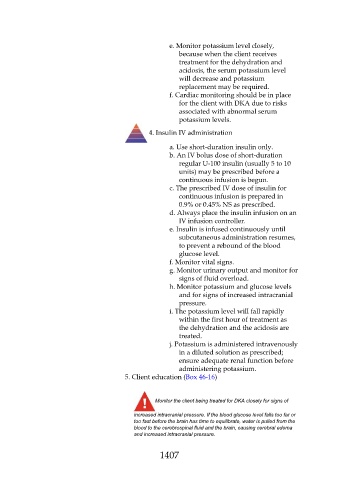Page 1407 - Saunders Comprehensive Review For NCLEX-RN
P. 1407
e. Monitor potassium level closely,
because when the client receives
treatment for the dehydration and
acidosis, the serum potassium level
will decrease and potassium
replacement may be required.
f. Cardiac monitoring should be in place
for the client with DKA due to risks
associated with abnormal serum
potassium levels.
4. Insulin IV administration
a. Use short-duration insulin only.
b. An IV bolus dose of short-duration
regular U-100 insulin (usually 5 to 10
units) may be prescribed before a
continuous infusion is begun.
c. The prescribed IV dose of insulin for
continuous infusion is prepared in
0.9% or 0.45% NS as prescribed.
d. Always place the insulin infusion on an
IV infusion controller.
e. Insulin is infused continuously until
subcutaneous administration resumes,
to prevent a rebound of the blood
glucose level.
f. Monitor vital signs.
g. Monitor urinary output and monitor for
signs of fluid overload.
h. Monitor potassium and glucose levels
and for signs of increased intracranial
pressure.
i. The potassium level will fall rapidly
within the first hour of treatment as
the dehydration and the acidosis are
treated.
j. Potassium is administered intravenously
in a diluted solution as prescribed;
ensure adequate renal function before
administering potassium.
5. Client education (Box 46-16)
Monitor the client being treated for DKA closely for signs of
increased intracranial pressure. If the blood glucose level falls too far or
too fast before the brain has time to equilibrate, water is pulled from the
blood to the cerebrospinal fluid and the brain, causing cerebral edema
and increased intracranial pressure.
1407

